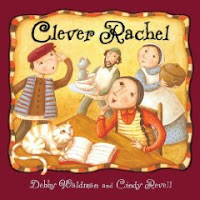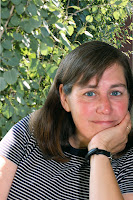I am thrilled to introduce author Debby Waldman. Debby’s first picture book, A Sack Full of Feathers, a charming retelling of a Jewish folktale, was published by Orca in 2006. She is also the author of WOW: World’s Outstanding Women Athletes (Sports Illustrated for Kids Books, 1998). Her picture book, Clever Rachel (Orca), was published in the fall of 2009. Her third picture book, Room Enough for Daisy, written with Rita Feutl, will be published in 2011. Debby’s articles and reviews have appeared in a variety of publications including People, Parents, Sports Illustrated, Sports Illustrated for Kids, Publishers Weekly, American Baby, Chatelaine, Glamour, and The Washington Post.
Debby is married and has two children. Her daughter, who is hard-of-hearing, inspired her to co-write Your Child’s Hearing Loss: What Parents Need to Know (Perigee, 2005) with audiology professor Dr. Jackson Roush. An updated version, Your Child’s Hearing Loss: A Guide for Parents, was published in the fall of 2009 by Plural Publishing. Debby was born and raised in Utica, NY, and now lives in Edmonton, Alberta. When not working on one of her many writing projects, she enjoys reading, cycling, baking, attempting to make nutritionally balanced meals for her family, and ferrying her children to music lessons and sports activities.
Your picture books are based on Jewish folktales. What appeals to you about these traditional stories?
They’re solid stories. The fact that they’ve been around for so long means that they’re timeless. Maybe some of the superficial details change: setting, character names and occupations, clothing — but the gist of the story and the message stay the same. I also enjoy the challenge of finding a new way to tell the story while retaining the message.
What were the challenges you faced in retelling the stories?
In some ways it’s the same with any story — figuring out the right way to tell it. A Sack Full of Feathers was easier than Clever Rachel, in part because I didn’t change the story that much: like the other versions, mine was about someone with a big mouth who has to learn that just because you know something (or think you do) doesn’t mean you should be blabbering about it to the entire world. Unlike the other versions I had seen, my blabbermouth was a boy, Yankel. As it turns out, that made it a perfect fit for Orca, which publishes children’s books where the main characters are children.
At some level, I modeled Yankel after myself. I love telling stories: I like entertaining people and I know how tempting it is to make the story bigger and more exciting because that’s what people seem to want to hear. But my background is journalism and I’m very careful to get my facts straight. My biggest fear as a writer is that I might misinform people. Yankel wasn’t thinking about the consequences, of the harm that could be caused by his highly inaccurate tales. He had to learn that lesson. Rewriting Clever Rachel was a bigger challenge. A woman who knows a lot about books for Jewish children told me about the folk tale and said she’d like to see it rewritten for kids. I read some versions and did not like the message that leapt out at me: a woman agrees to marry an arrogant jerk who tells her that if she disagrees with him, he’s going to kick her out of his mansion and send her back to her father’s inn. I thought, “What kind of woman would agree to THAT?” But I figured if this person who knew a lot about books for Jewish children liked the story there had to be some merit to it.
I wrote so many drafts. In the worst one, Rachel was a clever young teen who used riddles to help her family escape from the Nazis. I looked at it and thought, “This is ridiculous. This is not a picture book.” Then I asked myself, “Why does this girl like riddles so much?” And when I answered that question — because it’s how her dad put her to bed when she was little — I had my story. It kind of wrote itself. It was amazing. I felt as if I’d turned the story on its ear. I kept the important message — that the best way to solve problems is to cooperate — and some of the original riddles, but I made it more palatable or, at least, more palatable to me.
My next picture book is also based on a Jewish folk tale — the one about the man who thinks his house is too small until the rabbi tells him to bring first one animal and then another and another inside. It’s called Room Enough for Daisy, and I wrote it with Rita Feutl, a fellow writer and friend here in Edmonton. We were talking about folk tales one day and it turned out we both knew that one, but she knew the Ukrainian version (no rabbi) and I knew the Jewish version (rabbi). She had a great idea for rewriting it with a current twist and I said, “You should write it!” and she said “You should write it!” and I said “You should write it!” and she said, “You should write it!” and I said, “We should write it together!” and we did, and it’s been magical. Orca is going to publish it in 2011. Cindy Revell, who illustrated Sack and Rachel, is going to illustrate. It’s got some wonderful messages — Mitzvah Day, recycling, decluttering. And it’s fun.
How did you become a children’s writer?
A friend of mine from my synagogue here in Edmonton wanted to write a Passover story based on her daughter’s ambivalent relationship with the concept of Elijah. This was about fifteen or sixteen years ago. I was writing articles, essays, and reviews for magazines, and she asked if maybe we could write a picture book together. I’d never written a picture book but I thought, “Well, this could be interesting. And fun.” It was both, although the story never did get published. We sure got lots of nice rejection letters, though. I’d still like to have it published, but that’s another story. After that I decided I wanted to write another picture book. I knew a wonderful writer in town who wrote picture books based on folk tales from his native Africa. I thought to myself, “There are some great Jewish folk tales. I think I’ll try a Jewish folk tale.” The story about the feathers appealed to me because of the gossip-accuracy issues. I’m working on a couple more Jewish-themed picture books. Neither of them are based on folk tales, but one is set in Olkinik, the ancestral village of my dad’s family, and the place where I set both Sack and Rachel. In fact, Yankel is going to make another appearance.

What do you enjoy most about your work?
That I have the freedom to write what I want, and that there are people who want to publish it, and other people who want to read it. How wonderful is that? How blessed am I? (Very and very, to answer my questions.) I also enjoy visiting schools and libraries and community centres, reading my stories, and talking to people about writing.
I wish I’d met more writers when I was growing up. I wish I’d met even one! But they were mythical creatures as far as I was concerned because I never laid eyes on one until I was a young adult. I remember the first writer I interviewed when I was working as a newspaper reporter. Her name was Hannah Pakula and I was prepared to be thoroughly intimidated by her because her husband had directed the movie, “All the President’s Men,” AND she had written a massively researched biography, The Last Romantic, about Queen Marie of Roumania. But Hannah was wonderful — warm, friendly and encouraging. Talking to her was like talking to a friend. She made me believe I could be a writer, but a few decades had to pass before I felt comfortable calling myself that.
For a long time I felt that if I called myself a writer I was being pretentious. I called myself a freelance writer. That didn’t sound quite as pretentious. My first book was a work-for-hire about women athletes, for Sports Illustrated for Kids Books. It was fun to research and write, but I had a hard time thinking of it as a “real” book because it was about the size of a comic book and none of the stories inside were more than 400 words. I think it had more photos than words. In 2003 I co-wrote a book for parents of children who are hard of hearing (my 14-year-old daughter has worn hearing aids since she was three and I wrote the book to help myself and my husband and other parents in our situation). I consider that my first real book, but because it wasn’t a novel and would never have been considered a candidate for, say Oprah’s Book Club, I still had trouble thinking of myself as a writer.
I remember the first time I saw myself identified, in print, as an author — it was at the end of a book review I’d written for my local newspaper. I thought, “That’s misleading! I’m not an author!” and then it occurred to me, “I guess I am.” By that time I’d had three books published, so I decided it was probably okay to think of myself not only as a writer, but also an author.
What is your favorite children’s book?
Well, I don’t have just one. Growing up my favorite book was The Outsiders, by SE Hinton. I read that book so often during junior high and high school that I practically rubbed the print off the pages. In junior high I also discovered Night, by Elie Wiesel. Those two books made me want to become a writer. But I also loved the All of a Kind Family books by Sydney Taylor, Harriet the Spy, Lisa Bright and Dark and Edgar Allen by John Neufeld, the Karen series by Marie Killilea, and any biography. I read every biography in my elementary school library. I still love biographies. (Right now I am reading Open, Andre Agassi’s autobiography. It’s very hard to put down.) As for picture books, when I was little I remember liking The Carrot Seed, Curious George, and Make Way for Ducklings. My favorite picture book for the past couple of years has been Bagels from Benny by Aubrey Davis. I absolutely adore that book. I think it is the most wonderful rendition of a folk tale. It makes me laugh and think every time I read it. I also quite like Raisel’s Riddle by Erica Silverman, Something from Nothing by Phoebe Gilman, Chrysanthemum by Kevin Henkes, and all of the Frances books by Russell and Lillian Hoban.
Debby, thank you so much for taking the time to share so much about your creative process!
To learn more about Debby, please visit her website at debbywaldman.com.
